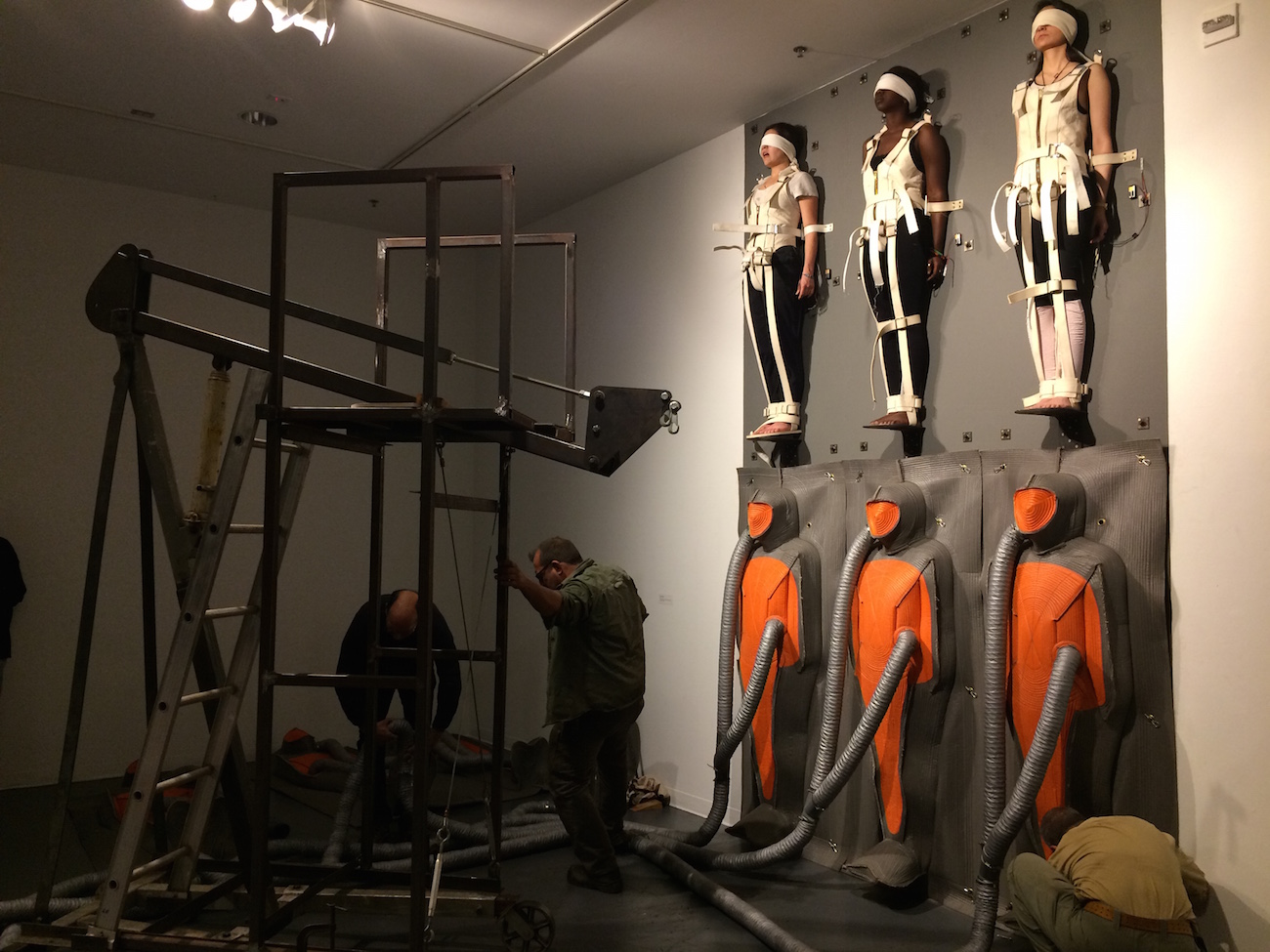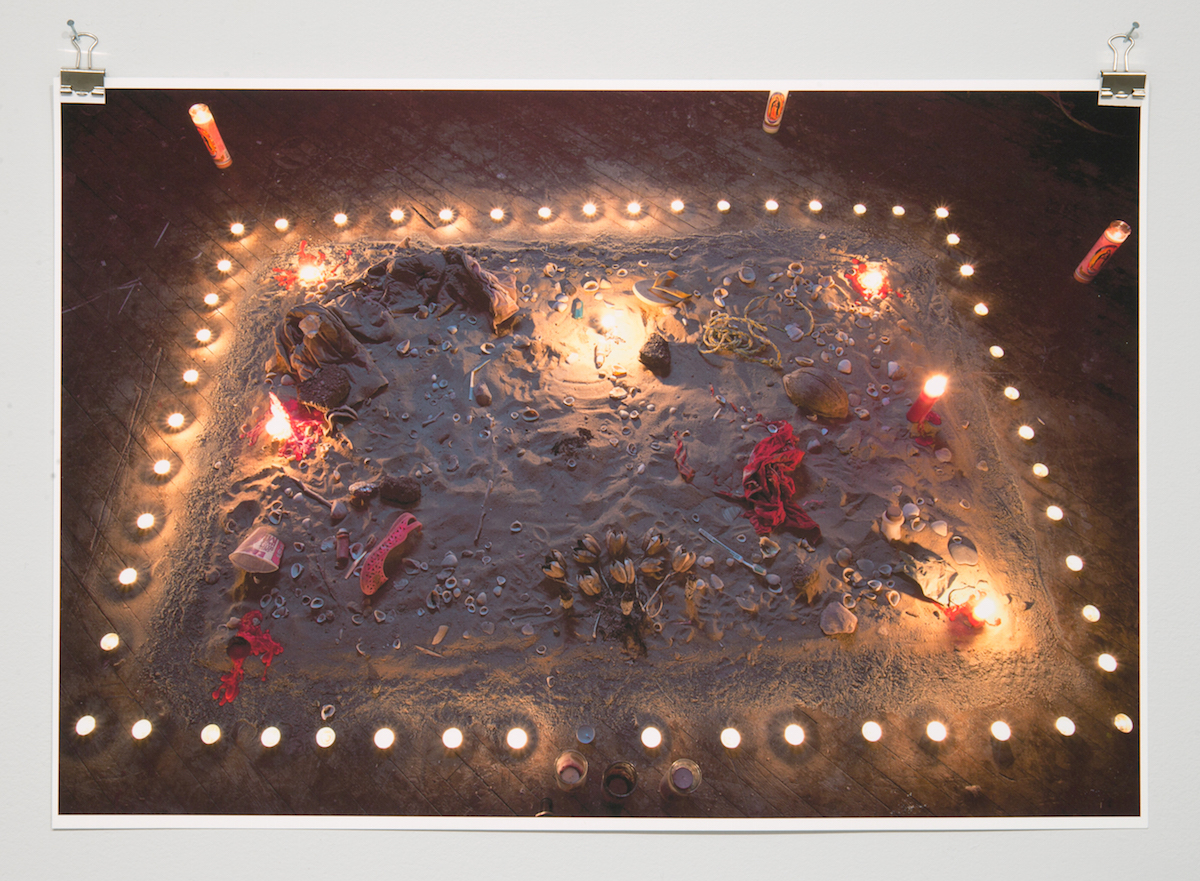Erick Antonio Benitez explores Mexican Migration in Esta Tu Tierra Es Tu Tierra, a New Cxhibit at Current Space by Angela N. Carroll
The US Mexican border es una herida abierta where the Third World grates against the first and bleeds. And before a scab forms it hemorrhages again, the lifeblood of two worlds merging to form a third country—a border culture. – Gloria Anzaldua, 1987
Imagine being forced by war or desperate circumstance to leave your home, your country, forever. Imagine the feeling of foregoing fleeting comforts for fragments; you can only take what will fit into a backpack—objects light enough to keep you agile, things that will not be a burden on the journey. What precious keepsakes can be bartered for safe travel? The campaign to the border is long and arduous. What would you sacrifice for freedom? Migrating bodies lose limbs, sleep, security, the ability to say no.
At Current Space, Erick Antonio Benitez’s exhibition Esta Tu Tierra Es Tu Tierra pays tribute to migrants, and considers the unholy journey of migration as a sacred hajj, an epic tumultuous pilgrimage towards possibility: the dream of America.
Benitez uses photography, found objects, and documentary to tell migration stories from those who have survived the crossing from the Gulf of Mexico through Tijuana towards the US/Mexico border.

“I am first generation Salvadorian American,” he explains. “A lot of my family came here illegally. It began in the Reagan era when the US government helped back the military government of El Salvador in the eighties which forced a lot of people to migrate. My mother was pregnant on the way. That was very impactful.”
This impact translates directly into the work, where photographs and moving images are composed like windows and many peer at subjects through border gates. Benitez’s documentaries further illustrate this through interviews with families that are forced to meet on opposite sides of the border. The sterile presentation is clearly reminiscent of visitation at a prison.
Benitez agrees. “That’s exactly what it feels like. That location [where I filmed] is actually named Friendship Park. Its really strange. In most border sites from the US side, you can’t get closer than 100 feet. So they created a park so that you can get closer to the border to see somebody. And they only operated during weekends. They have a lot of rules, there are border agents everywhere. The whole place is heavily militarized.”

Benitez captures the expansiveness and dense surveillance of the border and migrant experiences in four installations: a collection of photographs, train tracks, and two documentaries titled “La Frontera Phase One” and “La Frontera Phase Two.” The collective series is a sacred meditation on the unspoken sacrifice and trauma of migration.
The “Frontera” documentaries are displayed as two separate altar installations; each screen is flanked by border soil, sea shells, burning Seven Day Saint candles and the ephemera of migrant travel; discarded water bottles, shoes, clothes or trash.
Benitez shared his process for collecting objects from the border to display within the installation. “All of the items were collected from different sites,” he says. “I find a lot of articles of clothing. A little girl’s sandal. Water bottles. The essentials, just on a survival level. I can imagine the clothing being the things you lose over time, going over rivers, across deserts, over fences and the things you lose or have to get rid of to make a lighter load. All the objects carry energy.”

I cradled myself in a corner beside the altar of “La Frontera Phase Two,” listening as four men shared their stories. They, the lucky ones, had made it to the border, but what they sacrificed is unimaginable. Each man lost a limb to “La Bestia” (translation: The Beast), the train that carries migrants towards the border and often kills or maims its riders in the process. The train does not halt for screams. The train did not halt as flesh tore or bone cracked. Listening to the men’s horrific experience made me mourn the life-altering sacrifices all migrants endure in pursuit of freedom.
In “La Frontera Phase One” the border is presented as a subdued landscape that stretches for two thousand miles; a serene beige, blue and gray mirage, a distant and benign presence. The video charts Benitez’s ten-day journey through US border states, where long wide-angle shots of the land and the border silently loop. A rusty segment of the border train track is installed adjacent to the screen.

The quiet urgency of “La Frontera Phase One” resounds when coupled with the interviews of Phase Two. Research gathered by the Southern Poverty Law Center revealed that, between 2004 and 2011, an average of 223 bodies have been found every year in the Tucson sector of the Arizona border, a highly traveled route taken by border crossers. Thousands of migrants have perished in the borderlands. As startling as those numbers are, they do not include the hundreds of skeletal remains found in the border lands between Mexico, Guatemala, Honduras, and El Salvador that were too eroded to identify.
Many border crossers are kidnapped and illegally detained en route to the border. The detention can last for months, sometimes years. Minutemen, white extremist militia members, detain and monitor the migrants in prison-like containment shelters that are extensions of county jails.
Benitez visited and photographed one such facility, Tent City Jail, a containment shelter in Maricopa County, Arizona. Founded in 1993 by rogue Sheriff Joe Arpaio, the unsanctioned, largely illegal prison has the capacity to house 2,500 migrants. An estimated 800-900 migrants have occupied the outdoor camp where the dry heat of the desert can rise to 130 degrees.
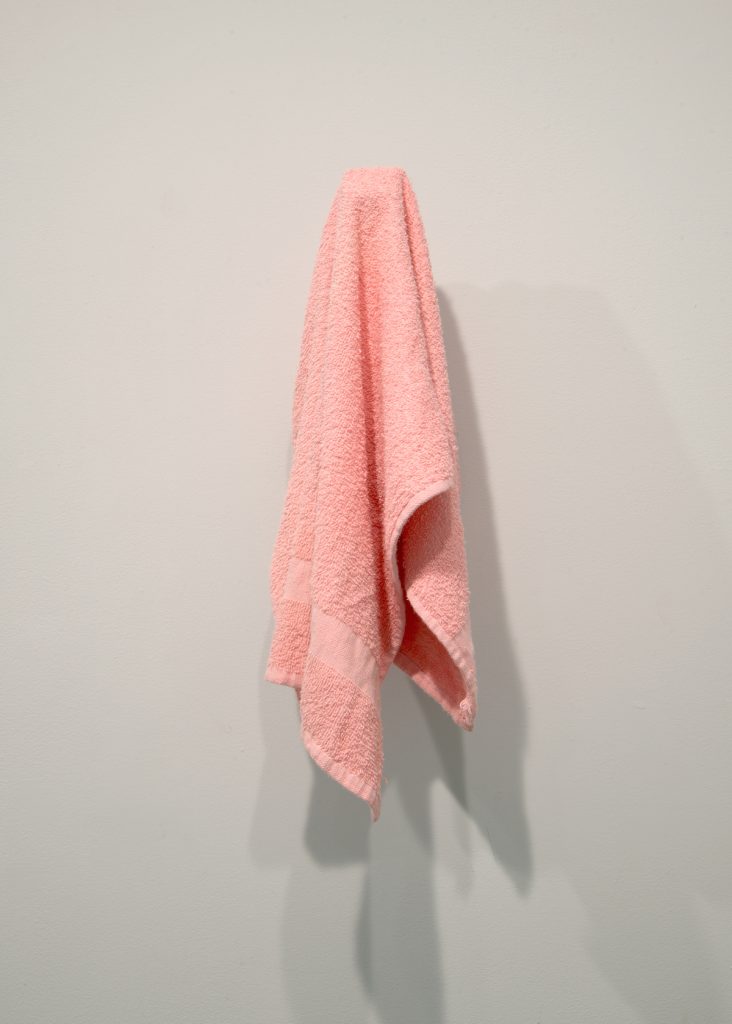
The documentation captured by Benitez reveals the bleak and inhumane conditions he observed; makeshift clothing lines, outdoor bathing facilities, and burial markers that surround the camp. Even more disturbing than the horrid living conditions of the jail, are the bizarre psychological emasculating rituals prison guards enforce on detainees.
The men are forced to wear bright pink prison uniforms, and use pink towels and soap. “Tent City Jail Inmate Towel” is an actual towel taken from the illegal facility, rehung in the installation as a reminder of the psychological as well as physical abuses border-crossers suffer. For further information about the jail, read the following report filed against Arpaio by the Department of Justice.
Benitez intends to continue his research and expand the conversation to include other migrating populations. “This piece will exist for as long as the problem exists, the systems of immigration,” says the artist. “It should be an ongoing project because of that. I want to explore the idea of imprisonment, militarization at the border, migration from Africa and the Middle East. It’s all relevant. it’s important for me to do this because I know that a lot of people know the situation exists but it’s sort of distorted for them.”
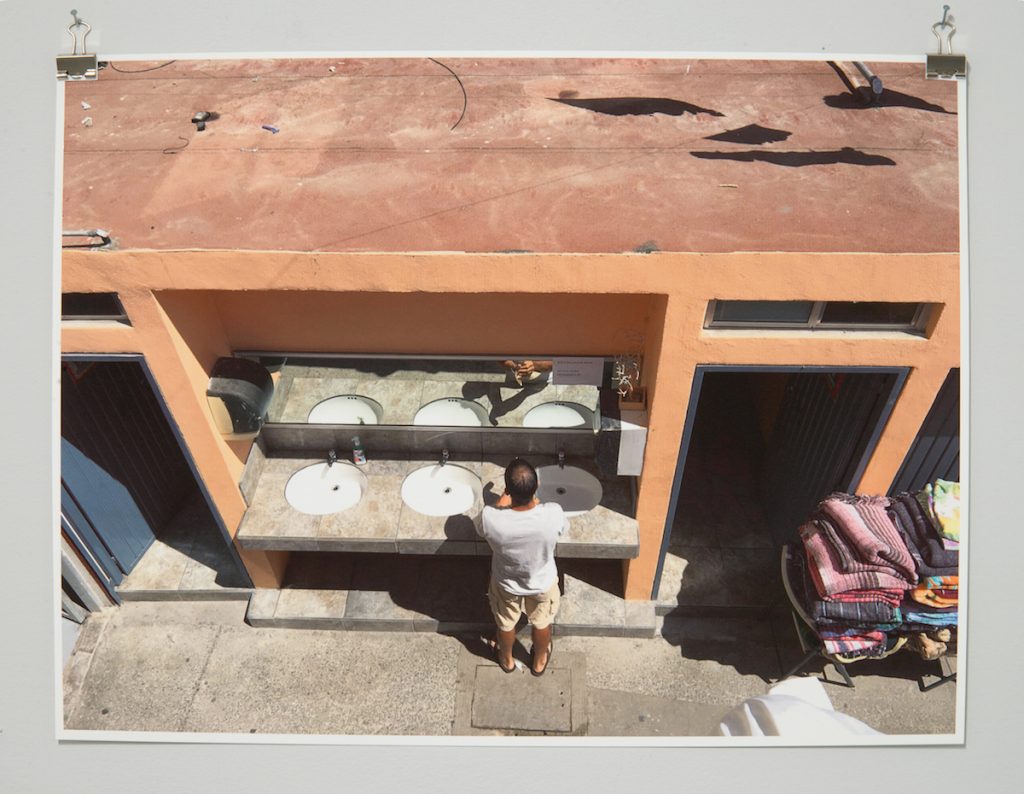
Americans are afraid of immigrants. Media outlets portray migrant populations as violent, as inherently dangerous detrimental leeches to the democratic freedoms of first world nations. The President-Elect of the United States has proposed the broadened construction of walls and strongholds to strengthen the border and prevent further invasion.
We have forgotten who the land belongs to, whose hands have always toiled and labored to found our nation. America was built on the backs of migrants, those forced into labor by colonization and enslavement, and those who migrated to escape war, poverty, and famine; all those whose lack of opportunity catalyzed their arrival on European and American shores.
“Esta Tierra Es Tu Tierra” literally translates to “This Land Is Your Land.” Now, more than ever, we must stand alongside the people most at risk, who are most vehemently attacked, belittled, and kept out.
Now more than ever before we must unite in the protection of America’s basic constitutional premises. This land was not made for white supremacists, it was birthed from the blood and toil of Others like me, like Benitez, and the thousands of others who are unknown but whose sacrifices will never be forgotten.
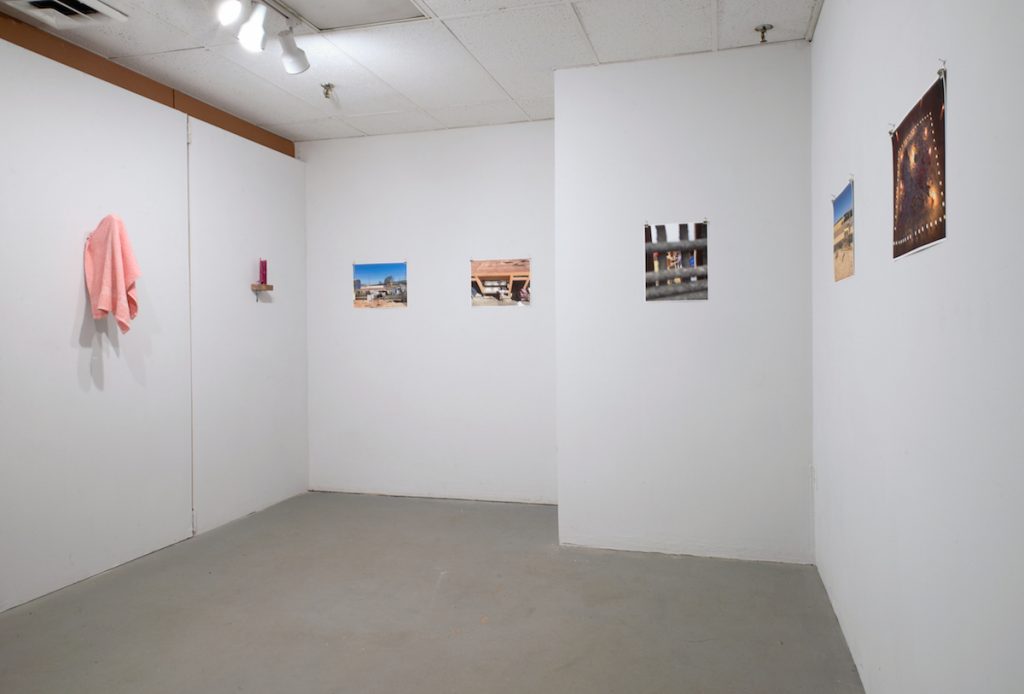
*******
Author Angela N. Carroll is an artist-archivist; a purveyor and investigator of contemporary culture.
Esta Tierra Es Tu Tierra is on display at Current Space Gallery thru November 19th. Visit the Closing Reception on November 19th 7-10pm to view additional video footage, installations and hear the artist talk by Erick Antonio Benitez.
Collaborating Organizations: Border Angels, Sacred Hearth Church, Amiredis (Association of Migrants Returned with Disabilities), El Desayunador, Casa Del Migrante
Funding provided by The Ruby Grants, a GBCA project in Baltimore.

